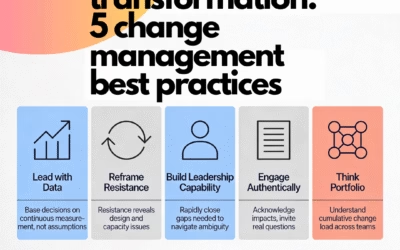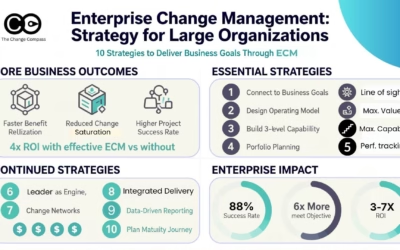For ambitious organisations undergoing constant transformations, effective change management is no longer a “nice-to-have” function; it’s a critical enabler for organisational success. As organisations face increasing complexity, digital transformation, and shifting market demands, the need for high-performing change management teams has never been greater. We see this not only in the increasing number of change management professionals hired year after year, but also in the number of organisations that have established change teams. Yet, building and leading such teams requires thoughtful planning, strategic alignment, and continuous development.
What is the role of a change management team within an organization?
A change management team plays a crucial role in guiding organizations through transitions. They assess the impact of changes, develop strategies for implementation, and support employees throughout the process. By ensuring effective communication and training, they help minimize resistance and foster a smoother adaptation to new systems or practices.
Let’s explores how senior change leaders can pragmatically approach the challenge of creating and sustaining high-performing change teams. We will address the critical components: delivering foundational value, aligning services with business priorities, assembling the right skills mix, demonstrating value to senior leaders, and nurturing the team’s growth and adaptability.
For any change management team, delivering on core responsibilities—what we might call “bread-and-butter” work—is non-negotiable. This foundational layer includes supporting initiatives through roles such as doer, advisor, and coach.
Why It Matters
Without effective delivery of these baseline change activities, a change team risks being perceived as ineffectual, which can undermine its ability to gain organisational trust and expand its remit. For example, if a team fails to facilitate smooth transitions for a large ERP implementation, it will struggle to advocate for strategic roles like change portfolio management.
Best Practices
Role Fluidity: Team members should be adept at switching between executor, advisor, and coach, depending on project needs. For example:
Doer: Crafting communication plans or conducting impact assessments to achieve the desired future state.
Advisor: Guiding project leaders on resistance management strategies.
Coach: Equipping sponsors with the skills to champion change.
Add Measurable Value: Clearly articulate the impact of core activities. Metrics such as adoption rates, speed-to-productivity as a starting point post-change, and stakeholder satisfaction can demonstrate the team’s contribution to project success.
Collaborative Engagement: Build strong relationships with project managers, sponsors, and functional leaders. Their endorsement is crucial for long-term credibility.
2. Getting the Service Mix Right
While core delivery is essential, the broader range of services a change team offers can set it apart. However, not all services are equally valued by senior leaders, nor are they always aligned with organisational priorities.
Key Service Areas
Change Champion Network Development: Empowering a distributed group of change agents to reinforce change locally.
Change Project Delivery: Executing change management tasks within specific initiatives.
Change Deployment Coaching: Guiding teams during go-live phases to sustain momentum.
Change Leadership Development: Coaching leaders to embed leadership skills and change management as a core capability.
Communication Support: Ensuring timely, targeted, and transparent messaging.
Change Portfolio Management: Overseeing change impacts across initiatives to manage saturation and optimize benefits.
Governance Design: Establishing structures and processes to guide change effectively.

Aligning Services with Business Priorities
Change Saturation Management: In a heavily loaded initiative environment, prioritizing the types of changes in change portfolio management helps mitigate operational risks and ensures benefit realization.
Agile Transformation: If agility is the organisational focus, the change team should specialize in scaled agile practices, supporting iterative delivery models and coaching on agile mindsets.
Change Saturation Management: In a heavily loaded initiative environment, prioritizing change portfolio management helps mitigate operational risks and ensures benefit realization.
Engage senior leaders to identify which services align most closely with the organisation’s strategic goals. This alignment ensures that the team’s contributions are recognized as essential rather than discretionary.
The Challenge of Over-Focusing on Methodology in Change Teams
Change management methodologies provide an essential foundation for developing a shared understanding of new processes, tools, and best practices. They enable consistency, structure, and a degree of predictability in how change initiatives are supported. However, when change teams become overly focused on methodology, it can result in a rigid and insular approach that diminishes their ability to address the business’s most pressing challenges.
The Risks of Methodology-Driven Approaches
An excessive emphasis on methodology often shifts the team’s focus inward, prioritizing process perfection over business impact. This can manifest as an overuse of templates, theoretical frameworks, and “one-size-fits-all” solutions that fail to account for the nuances of the organisation or the unique demands of specific initiatives. For example, insisting on completing a detailed change impact assessment for every project, regardless of scale, can delay progress and frustrate stakeholders who need swift, actionable insights.
This insularity can also lead to a disconnect between the change team and business stakeholders. Leaders and teams on the ground may perceive the change team as out of touch with operational realities, focusing on delivering “change management artifacts” rather than practical solutions that align with a shared vision of the real-world challenges. In fast-paced or high-pressure environments, this misalignment risks eroding trust and marginalizing the change team’s role.
A Pragmatic Alternative: Stakeholder-Focused, Evidence-Driven Change
Rather than being bound by methodology, high-performing change teams adopt a business stakeholder-focused approach combined with evidence and data-driven practices. This pragmatic mindset places business needs at the centre, using methodology as a flexible guide rather than a rigid framework.
Stakeholder Focus: Engage directly with business leaders and teams to understand their priorities, pain points, and desired outcomes. For example, a senior leader driving a rapid digital transformation may value quick wins and adaptability over comprehensive documentation. Tailoring the approach to these needs ensures the change team delivers value where it matters most.
Evidence and Data-Driven Approaches: Leverage data to identify what works and where to focus efforts. For instance, analysing adoption metrics, employee feedback, and performance KPIs can guide targeted interventions that yield measurable benefits. This approach also reinforces credibility with data-driven executives who prioritize ROI and tangible outcomes.
Dynamic Flexibility: Treat methodologies as a toolkit rather than a blueprint. Select and adapt tools to fit the specific context, whether it’s a cultural shift requiring storytelling and leadership coaching or a technology rollout needing structured training and communication plans.
The Payoff
By balancing methodological discipline with a pragmatic, stakeholder-cantered approach, change teams can position themselves as indispensable partners to the business. They demonstrate agility, relevance, and an unwavering focus on delivering outcomes that matter most. This approach not only strengthens the team’s impact but also enhances its reputation as a value-adding function critical to organisational success.

3. Assembling the Right Skills Mix
High-performing change teams require a blend of tactical expertise and strategic acumen.
Skill Types and Their Roles
Doers: Strong executors who thrive on delivering tangible outputs such as plans, training materials, or stakeholder maps.
Strategists: Analytical thinkers who assess organisational readiness, map interdependencies, and develop long-term approaches.
Connectors: Relationship builders who excel in stakeholder engagement and influence.
Coaches: Practitioners skilled in developing leadership capabilities and fostering cultural shifts.
Team Composition Tips
Balance Is Key: A team overly focused on execution may miss strategic opportunities, while one that’s too strategic risks losing touch with operational realities.
Flexible Hiring Models: Use a mix of permanent staff and contractors to adjust capacity based on demand. For example, during a merger, bring in experienced change contractors to handle the surge in activity.
Cross-Skilling: Encourage team members to develop multiple capabilities. For instance, a project-focused doer can learn coaching techniques to support leadership development.
4. Demonstrating Value to Senior Leaders
A change management team’s success is often assessed by its ability to demonstrate value in ways that resonate with executives.
Why This Is Crucial
Senior leaders control the budget and influence the perception of the function. If the team’s impact is not clearly tied to organisational success, it risks being deprioritised, particularly in times of financial pressure.
Strategies for Executive Engagement
Speak Their Language: Frame the team’s contributions in terms of business outcomes—cost savings, faster time-to-market, or improved employee retention.
Example: Instead of stating, “We conducted 20 training sessions,” say, “Our training program resulted in a 30% reduction in time-to-productivity for new systems.”
Prioritize Strategic Contributions: Focus on high-impact services like change portfolio management, which directly affect operational resilience and benefit optimization. Ensure that support resources are readily available during this process to enhance effectiveness.
Visualize Success: Use dashboards or scorecards to track and communicate metrics such as initiative adoption rates, change saturation levels, and benefit realization.
5. Nurturing, Motivating, and Developing the Team
Building a high-performing team is not a one-time effort; it requires ongoing attention to culture, engagement, and professional growth.
Key Practices
Measurement and Feedback: Regularly assess team performance through metrics, stakeholder feedback, and self-assessments. Use these insights to identify strengths and improvement areas.
Situational Leadership: Tailor your leadership style to the needs of individual team members.
Example: A novice practitioner may require hands-on guidance, while a seasoned professional benefits more from empowerment and strategic challenges.
Recognition and Reward: Celebrate successes—both individual and collective. Recognize achievements in team meetings, emails to leadership, or formal awards.
Development Opportunities: Invest in training, and cross-functional assignments. For example, a team member focused on project delivery could benefit from a course in portfolio management.
Foster Psychological Safety: Encourage open dialogue, idea-sharing, and risk-taking without fear of blame. This is critical for innovation and resilience during challenging periods.

6. Overcoming Common Challenges
Building and leading high-performing change teams is fraught with obstacles, but proactive strategies can mitigate these risks.
Challenge: Balancing Demand and Capacity
When multiple initiatives demand simultaneous support, the team can become overstretched.
Solution: Implement a tiered support model, where high-priority projects receive full support, and lower-priority ones get advisory services.
Challenge: Gaining Buy-In for Strategic Services
Executives may undervalue strategic offerings like change portfolio management.
Solution: Pilot a portfolio management framework for a specific division, demonstrate its benefits, and then scale.
Challenge: Retaining Talent in a Competitive Market
Experienced change practitioners are in high demand.
Solution: Foster a compelling employee value proposition, including career progression, meaningful work, and a supportive culture.
Case Study: Building a High-Performance Change Team During a Merger
Scenario: A global manufacturing company underwent a merger, leading to significant cultural and operational integration challenges.
Approach:
Core Delivery First: The team focused on ensuring smooth transitions for critical systems (ERP, payroll) to build credibility.
Strategic Pivot: As the merger progressed, they introduced a change portfolio management framework to coordinate initiatives and avoid saturation.
Tailored Skill Development: Team members received targeted training in M&A-specific change management, enhancing their ability to address unique challenges.
Executive Engagement: The team provided a dashboard linking adoption metrics to merger goals, securing ongoing leadership support.
Outcome: The team was recognised as a critical enabler of the merger, with their scope expanded to include leadership development for post-merger integration.
Building and leading a high-performance change management team is as much about strategy and alignment as it is about delivery and culture. By focusing on the foundational “bread-and-butter” work, aligning services with business priorities, fostering a balanced skills mix, demonstrating measurable value, and nurturing team growth, senior practitioners can create teams that are not only effective but indispensable to organisational success.
For those leading change teams, remember: your success is ultimately reflected in the impact you create for the business. Ensure your contributions are visible, valuable, and aligned with what matters most to your stakeholders.






